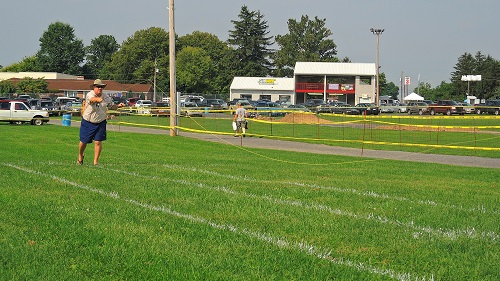You are using an out of date browser. It may not display this or other websites correctly.
You should upgrade or use an alternative browser.
You should upgrade or use an alternative browser.
Fishidiot
Blue Liner Flows Review | USGS Stream Gauges
Jun 18
- 275
- 2
All water level data originates from the United States Geological Survey (USGS) Surface-Water Data, which monitors over 13,000 stream gauges across the U.S. and more than 350 in Pennsylvania. The USGS has been transitioning to a new online interface over the past five-plus years. The updated look and feel have left some old features behind while adding new ones. I hate it.
So, I’ve been on the hunt for a desktop and mobile app that delivers USGS backend data through a clean, easy-to-use interface. Blue Liner Flows offers a solid solution for iPhone, iPad and Mac users, with apps built for both platforms. Most importantly, favorites and preferences sync across devices. There’s a free version, but I’ll be reviewing the $6.99 annual paid version.
Key features include: favorites, state selection, map view, latest data overview, discharge in CFS, discharge in feet, average annual discharge, various time views, weather forecasts, alerts, temperatures (station-dependent), turbidity (station-dependent), and other data specific to each gauge.
I found the app very easy to set up on my Mac. Once configured, all my favorites and alerts synced automatically to my iPhone. You don’t need both devices—an iPhone alone works just fine. I especially liked navigating between the state, favorites, and map views. It’s fast and intuitive. Most views display the key information I’m looking for, including directional arrows indicating whether water levels are rising or falling.
[ATTACH type="full" width="720px"...
Stonecats for Warm Water Anglers
Sep 01
- 829
- 0
In a recent stream report I indicated using a "stonecat" fly. For many PA FFers, this is an unusual pattern and not typically associated with trout fishing. Local river folks who fish bait for smallies, however, are very familiar with this critter.
The term "stonecat" is actually a misnomer and refers to a madtom found in western PA. The fish we have in the Susky/Potomac watershed is actually the marginated madtom. However, local folks have always called marginated madtoms "stonecats." Afishinado will tell you that locals in his home stomping grounds around Wilkes Barre call 'em "catties." They're a popular live bait.

Stonecat
Marginated madtoms are a shy, mysterious, largely nocturnal little catfish and many river anglers have never seen one. Bait fishermen often get them by seining weedy riffle areas at night or carefully feeling for them under rocks with their hands. Bass eat 'em like candy and, in my opinion, really key on the image of a stonecat. I love 'em, and stonecat flies are go-to patterns for summer bass for me, especially in clear water.
The fly I was using is one of a series of flies I've designed utilizing paint and craft felt. Like many of my personal patterns, it is realistic and detailed.
A much easier stonecat pattern would be tan or light brown sculpin wool for the head, a tan fur or chenille body, and a long tail of tan marabou. Tie a dumbbell weight Clouser style under the head so the fly swims hook upward and trim the head flat. Rubber band whiskers add a nice touch. The key, however, is to keep the fly very slender and very long.
Marginated madtoms are usually 2-5" in length and have a paddle like tail with a black edge; body is usually pinkish yellow on the ventral, light brown on the...
The term "stonecat" is actually a misnomer and refers to a madtom found in western PA. The fish we have in the Susky/Potomac watershed is actually the marginated madtom. However, local folks have always called marginated madtoms "stonecats." Afishinado will tell you that locals in his home stomping grounds around Wilkes Barre call 'em "catties." They're a popular live bait.

Stonecat
Marginated madtoms are a shy, mysterious, largely nocturnal little catfish and many river anglers have never seen one. Bait fishermen often get them by seining weedy riffle areas at night or carefully feeling for them under rocks with their hands. Bass eat 'em like candy and, in my opinion, really key on the image of a stonecat. I love 'em, and stonecat flies are go-to patterns for summer bass for me, especially in clear water.
The fly I was using is one of a series of flies I've designed utilizing paint and craft felt. Like many of my personal patterns, it is realistic and detailed.
A much easier stonecat pattern would be tan or light brown sculpin wool for the head, a tan fur or chenille body, and a long tail of tan marabou. Tie a dumbbell weight Clouser style under the head so the fly swims hook upward and trim the head flat. Rubber band whiskers add a nice touch. The key, however, is to keep the fly very slender and very long.
Marginated madtoms are usually 2-5" in length and have a paddle like tail with a black edge; body is usually pinkish yellow on the ventral, light brown on the...
2015 Mid Atlantic Fly Casting Championships
Jun 12
- 556
- 0
The Cumberland Valley Chapter of Trout Unlimited will be hosting its Annual Mid Atlantic Fly Casting Championships on June 20th, 2015 at Allenberry Resort in Boiling Springs, PA. The competition will be conducted in conjunction with The Pennsylvania Fly Fishing Museum 13th Annual Heritage Day Celebration. The Heritage Day event is a full day of celebrating the fly fishing heritage in Pennsylvania with over 60 vendors and exhibitors, hands on demonstrations, special seminars, instruction, raffles, auctions and the always popular Fish Swim Race on the Yellow Breeches for a chance to win $500! More information on Heritage Day is available on the Museum website: www.paflyfishing.org.
Article by Dave Weaver
Photo courtesy tomitrout
Another Great Fish – Old George
Mar 22
- 743
- 0
Part of the lore of fly fishing in Pennsylvania, and the Cumberland Valley in particular, revolves around stories of big fish, usually giant brown trout. Of course this comes as no surprise to fishermen, nevertheless stories of great fish, caught and got away, serve to set the stage for what might happen every time we visit Letort or some other famous stream. Among these famous fish stories, perhaps the best known is the story of “Old George” as recounted by famed Cumberland Valley fly fisher and fly tying innovator Ed Shenk (think “Letort Cricket” and other patterns). “Old George” was the name Ed gave to a very large trout he pursued for over a year in the upper Letort in the early 1960s. The fish dwarfed other browns in the same pool that were themselves over twenty inches. Ed carefully observed this particular fish and patterned its daily comings and goings (not surprisingly, Old George came out in the evening and returned to cover early in the morning) and described the great fish as being very light colored. He saw, hooked, and lost the fish multiple times. Finally, he caught the brown on a streamer fly in 1964. Old George taped just over 27 inches and weighed eight pounds. In a final twist in the story,
 Old George turned out to be a female. The story of Old George went on to become part of the lore of Pennsylvania fly fishing. Ed recounts the full story of Old George in the final chapter of his book Fly Rod Trouting.
Old George turned out to be a female. The story of Old George went on to become part of the lore of Pennsylvania fly fishing. Ed recounts the full story of Old George in the final chapter of his book Fly Rod Trouting.
On occasion, I’ll paint portraits of specific fish caught by anglers and using an old faded color photo and Ed’s description of the fish, it was my pleasure to paint a life sized image of Old George. This painting was presented recently as a gift to Ed at the 2015 Limestoner banquet held...

On occasion, I’ll paint portraits of specific fish caught by anglers and using an old faded color photo and Ed’s description of the fish, it was my pleasure to paint a life sized image of Old George. This painting was presented recently as a gift to Ed at the 2015 Limestoner banquet held...
An Award Much Deserved
Mar 31
- 1,629
- 3
An Award Much Deserved
By Dave Weaver
For Cumberland Valley Trout Unlimited and Paflyfish.com
A fine time indeed was had at the recent Cumberland Valley Trout Unlimited (CVTU) Limestoner Banquet. This is CVTU’s main fundraising event each year. Like many TU chapters, CVTU relies on volunteer efforts to complete a wide range of valuable endeavors and this includes putting together an annual banquet to raise funds. Among these outstanding endeavors, CVTU is involved in land preservation, youth fly fishing outreach in the form of the Rivers Conservation and Youth Camp and Trout in the Classroom; fly fishing schools for women, US military, and disadvantaged youths as well as wounded veterans.
Among our recent stream improvement projects during the last year include the Phase 2 project on Big Spring as well as projects to improve habitat in The Run in Boiling Springs, as well as restoration of habitat for native trout in a recovered lake bed. Every year, CVTU juggles an array of stream improvement and outreach programs designed to raise awareness and protect cold water resources and trout habitat across hundreds of square miles in the Cumberland valley and adjacent areas – an area encompassing many of our state’s best known trout streams but also dozens of lesser known freestone and limestone trout streams. And CVTU isn’t alone. Roughly fifty chapters of TU and the State Council are all in the fight.
In CVTU’s case, not only do we run a very nice banquet with the typical array of fun items to bid or purchase, but over twenty years ago the chapter decided to include a couple awards that would be presented at the banquet to deserving recipients. These include the...
The Pennsylvania Fly Fishing Museum Grand Opening 2013
Apr 25
- 1,353
- 0
By Dave Weaver
Earlier this month, the Pennsylvania Fly Fishing Museum celebrated its grand opening and many from our PAFF community were in attendance. This museum, as many of you know, has been an accumulating collection of our state’s legacy anglers’ equipment, papers, and flies etc for many years. Some of the collection has been on temporary loan to various communities around the state including here in Gettysburg. However, some of the best interpretive displays that many of you no doubt are familiar with have been displayed in a small museum located in a hallway in Fairfield Hall on the grounds of the Allenberry Playhouse. These displays are still there although the topic material has been rotated.
In recent years, as the museum’s collection has grown, there has been an effort to secure a larger space with the capacity for better displays showing the full fly tying desks or rod building shops of men like Vince Marinaro or George Harvey. These displays are similar to the ones that can be seen celebrating the Darbies or Wulffs in the Catskill Museum of Fly Fishing. In addition to Marinaro and Harvey, who have larger “rooms,” there are display booths for Joe Humphys, Jim Bashline, Ed Koch, Ed Shenk and several others. Speaking just for myself, when I gaze at the gear collections of so many great and innovative fly fishermen, I’m often struck at how basic and well worn their equipment was. These guys don’t often look as if they were kitted out with the latest high end stuff from the latest trendy catalog. In any event, if you’d like to check out the Pennsylvania Fly Fishing Museum’s website where you can see more pics of the museum, please hit: http://www.paflyfishing.org/.
You can also join or support the museum association.
It’s a wonderful museum - kudos to the volunteers from the museum association who have worked so hard for so long to bring this new museum wing to fruition for us to enjoy. If you’re joining me for the 8...
Earlier this month, the Pennsylvania Fly Fishing Museum celebrated its grand opening and many from our PAFF community were in attendance. This museum, as many of you know, has been an accumulating collection of our state’s legacy anglers’ equipment, papers, and flies etc for many years. Some of the collection has been on temporary loan to various communities around the state including here in Gettysburg. However, some of the best interpretive displays that many of you no doubt are familiar with have been displayed in a small museum located in a hallway in Fairfield Hall on the grounds of the Allenberry Playhouse. These displays are still there although the topic material has been rotated.
In recent years, as the museum’s collection has grown, there has been an effort to secure a larger space with the capacity for better displays showing the full fly tying desks or rod building shops of men like Vince Marinaro or George Harvey. These displays are similar to the ones that can be seen celebrating the Darbies or Wulffs in the Catskill Museum of Fly Fishing. In addition to Marinaro and Harvey, who have larger “rooms,” there are display booths for Joe Humphys, Jim Bashline, Ed Koch, Ed Shenk and several others. Speaking just for myself, when I gaze at the gear collections of so many great and innovative fly fishermen, I’m often struck at how basic and well worn their equipment was. These guys don’t often look as if they were kitted out with the latest high end stuff from the latest trendy catalog. In any event, if you’d like to check out the Pennsylvania Fly Fishing Museum’s website where you can see more pics of the museum, please hit: http://www.paflyfishing.org/.
You can also join or support the museum association.
It’s a wonderful museum - kudos to the volunteers from the museum association who have worked so hard for so long to bring this new museum wing to fruition for us to enjoy. If you’re joining me for the 8...
Update from the PFBC Big Spring Meeting
Nov 07
- 1,173
- 11
The meeting was well attended and the attendees included John Arway and many of the PFBC staff including the Area Fisheries Managers involved with this project. Also present were many prominent names in the Pennsylvania Fly Fishing Community who you would recognize as well as local folks and some Big Spring old timers. The meeting presented the plan for a new restoration section in 2013 and proposed some changes for the future. Among the audience, the main source of disagreement, not surprisingly, dealt with the issue of what (if anything) should be done about the rainbows. Here's the short version of the meeting:
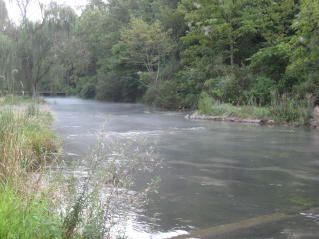 -PFBC biologists presented a ppt show describing the flow, cover, and depth changes in the section restored in 2010. The stream is now narrower, deeper, and slower, and has more non-vegetation cover and thus more "optimal" habitat for both brook and rainbow trout. The gravel used to block in the logs in this section is being used by rainbows for spawning and, in the future, smaller gravel should be used as this might reduce rainbow spawning success. Also, dissolved oxygen levels at the lower end of the FFO section and downstream into the ATW section are lower than optimal for wild trout.
-PFBC biologists presented a ppt show describing the flow, cover, and depth changes in the section restored in 2010. The stream is now narrower, deeper, and slower, and has more non-vegetation cover and thus more "optimal" habitat for both brook and rainbow trout. The gravel used to block in the logs in this section is being used by rainbows for spawning and, in the future, smaller gravel should be used as this might reduce rainbow spawning success. Also, dissolved oxygen levels at the lower end of the FFO section and downstream into the ATW section are lower than optimal for wild trout.
-PFBC ppt show describing the electrofishing results of the section that was restored in 2010 and the sections used as control. After the 2010 restoration, brook trout numbers increased (roughly doubled) and rainbow numbers increased in the restored section by a greater margin (roughly four fold). These were the results revealed in the 2011 fish survey. The recent 2012 survey of these same sections revealed that rainbows, although still more numerous in the restored section, had declined a bit in 2011-2012. Brook trout numbers continued to rise in this section and in the upstream control section from 2011 to 2012.
-Over the entire course of the FFO section of Big Spring, as of autumn 2012, the...

-PFBC ppt show describing the electrofishing results of the section that was restored in 2010 and the sections used as control. After the 2010 restoration, brook trout numbers increased (roughly doubled) and rainbow numbers increased in the restored section by a greater margin (roughly four fold). These were the results revealed in the 2011 fish survey. The recent 2012 survey of these same sections revealed that rainbows, although still more numerous in the restored section, had declined a bit in 2011-2012. Brook trout numbers continued to rise in this section and in the upstream control section from 2011 to 2012.
-Over the entire course of the FFO section of Big Spring, as of autumn 2012, the...
Pennsylvania Fly Fishing Museum Association Heritage Day 2012
Jun 25
- 900
- 9
The Pennsylvania Fly Fishing Museum Association Heritage Day was a fun and informative event, as usual. The weather was gorgeous and the turn out seemed good. I had the pleasure of hanging out with forum members Troutbert, Wetfly01, and dc410 among other Pa fly fishing luminaries. Good stuff. Enjoy the pics of us and some of the artist/vendors.

Forum members Fishidiot and Troutbert

New and old editions from Dwight Landis
(Link to interview on Paff)

Fly fishing stuff from Fishidiot found at www.rodandbrush.com
(link to interview on Paff)
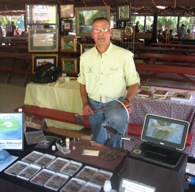
Forum member and wet fly master: Wetfly01
www.wetflywaterguides.com

Wetfly01’s handiwork

Artist Michael Simon
www.michaelsimonanglingart.com
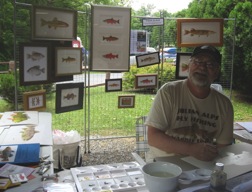
Fish artist Thom Glace
www.thomglacewatercolors.com
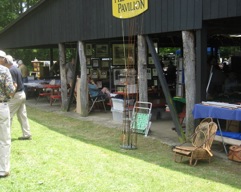
Allenberry pavilion
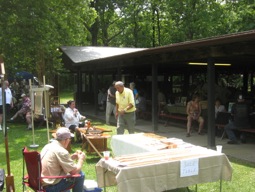
Lots of bamboo rod vendors
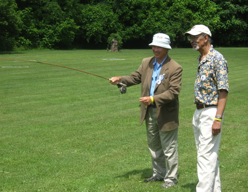
So much bamboo, so little time.
Forum member Lestrout typically finding the sweet spot.

Forum members Fishidiot and Troutbert

New and old editions from Dwight Landis
(Link to interview on Paff)

Fly fishing stuff from Fishidiot found at www.rodandbrush.com
(link to interview on Paff)

Forum member and wet fly master: Wetfly01
www.wetflywaterguides.com

Wetfly01’s handiwork

Artist Michael Simon
www.michaelsimonanglingart.com

Fish artist Thom Glace
www.thomglacewatercolors.com

Allenberry pavilion

Lots of bamboo rod vendors

So much bamboo, so little time.
Forum member Lestrout typically finding the sweet spot.
A Great Fish
Mar 05
- 1,832
- 18
This article is another in Dave Weaver’s on going “Casting through History” series. His previous article in this series was John Brown’s Bass.
 Over the years many of you, if you’ve visited Yellow Breeches Anglers in Boiling Springs, have probably gazed at one particular dusty old mounted brown trout. When I was a kid, I’d look at this fish and think that it wasn’t the best taxidermy job. If you’re a Cumberland Valley regular or otherwise familiar with the writings of Charlie Fox and others, you’re probably aware of the story behind this fish. If not, we’ll re-tell the story behind this dusty old trophy…..a veritable sacred relic of Pennsylvania fishing history.
Over the years many of you, if you’ve visited Yellow Breeches Anglers in Boiling Springs, have probably gazed at one particular dusty old mounted brown trout. When I was a kid, I’d look at this fish and think that it wasn’t the best taxidermy job. If you’re a Cumberland Valley regular or otherwise familiar with the writings of Charlie Fox and others, you’re probably aware of the story behind this fish. If not, we’ll re-tell the story behind this dusty old trophy…..a veritable sacred relic of Pennsylvania fishing history.
Ed Koch is part of Pennsylvania’s unique fly fishing heritage. His book Fishing the Midge is a classic and, like many of the writings of his generation, is always worth a re-read. Ed was also the long time owner of the Yellow Breeches fly shop. Many of you may remember chatting with Ed in the shop. This was Ed’s great trophy, caught from Letort Spring Run in August 1962. Charlie Fox recollects the story in his classic, This Wonderful World of Trout: Ed had hooked the fish three times previously. Finally, he saw the giant again and, after several casts, the big brown rose and ate a Letort Cricket, a popular deer hair dry fly. After a tough, twenty five minute fight in the weeds, the fish came to the net: 27 and a half inches and over nine pounds. Fox describes Koch’s trembling hands when the fish was weighed and photographed. Shortly later, the Fish Commission announced that this was the largest brown trout ever caught in Pennsylvania on a dry fly. Does this fish still hold this distinction today? I don’t know - perhaps. I think every fly fisherman dreams of that fish of a lifetime; a fish that takes perseverance and...

Ed Koch is part of Pennsylvania’s unique fly fishing heritage. His book Fishing the Midge is a classic and, like many of the writings of his generation, is always worth a re-read. Ed was also the long time owner of the Yellow Breeches fly shop. Many of you may remember chatting with Ed in the shop. This was Ed’s great trophy, caught from Letort Spring Run in August 1962. Charlie Fox recollects the story in his classic, This Wonderful World of Trout: Ed had hooked the fish three times previously. Finally, he saw the giant again and, after several casts, the big brown rose and ate a Letort Cricket, a popular deer hair dry fly. After a tough, twenty five minute fight in the weeds, the fish came to the net: 27 and a half inches and over nine pounds. Fox describes Koch’s trembling hands when the fish was weighed and photographed. Shortly later, the Fish Commission announced that this was the largest brown trout ever caught in Pennsylvania on a dry fly. Does this fish still hold this distinction today? I don’t know - perhaps. I think every fly fisherman dreams of that fish of a lifetime; a fish that takes perseverance and...
Book Review: Fly Fishing for Striped Bass by Rich Murphy
Aug 30
- 2,932
- 24
Fly Fishing for Striped Bass
Rich Murphy
Wild River Press, 2007
457pp
The claim that any book is “definitive” has always caused me to dismiss the reviewers glowing claims that inevitably follow – and I’ll not use the term in this review – but Fly Fishing for Striped Bass by Rich Murphy comes close to meeting this ideal. I’ve had the pleasure of chatting with Rich at the Somerset show in the past and marveling at his beautiful and innovative fly patterns. When I asked him if he’d ever caught a tautog on a fly (something I’ve tried to do for years, without any luck) he responded with a tone suggesting that it was downright easy.
Looking at his crab patterns, it doesn’t surprise me that ole Mr Tog would fall for ‘em. Anyway, this book, is simply put, a pleasure to read or just peruse. Replete with color photos on every page, it’s a coffee table book that reads just as well. In its 9 chapters, FFfSB starts with an intriguing chapter that follows the migration of “Sax,” a fictional, fifty pound cow bass on her migration up the coast.
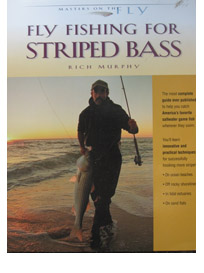 Other chapters describe the various techniques for flats, rocks, bays, etc as well as Rich’s excellent flies and other gear. Murphy, a driven, rail thin runner and type A angler is highly intelligent and you can sense his intense focus on every page. The book can be difficult to read in a bit too many sections and sometimes it seems that Murphy tries a bit too hard by half to find a sophisticated voice, writing too many passages like this:
Other chapters describe the various techniques for flats, rocks, bays, etc as well as Rich’s excellent flies and other gear. Murphy, a driven, rail thin runner and type A angler is highly intelligent and you can sense his intense focus on every page. The book can be difficult to read in a bit too many sections and sometimes it seems that Murphy tries a bit too hard by half to find a sophisticated voice, writing too many passages like this:
We know from Chapter 2 that a major physiological change happens in her eyes at sundown – the color receptors or cones on the surface of her eye’s retina retract and contrast detecting receptors, or rods are deployed in their place. This enhances her capacity to detect subtle changes in the contrast gradient of the water column around her caused by the movement of her prey or predators…My surface night patterns are configured to...
Rich Murphy
Wild River Press, 2007
457pp
The claim that any book is “definitive” has always caused me to dismiss the reviewers glowing claims that inevitably follow – and I’ll not use the term in this review – but Fly Fishing for Striped Bass by Rich Murphy comes close to meeting this ideal. I’ve had the pleasure of chatting with Rich at the Somerset show in the past and marveling at his beautiful and innovative fly patterns. When I asked him if he’d ever caught a tautog on a fly (something I’ve tried to do for years, without any luck) he responded with a tone suggesting that it was downright easy.
Looking at his crab patterns, it doesn’t surprise me that ole Mr Tog would fall for ‘em. Anyway, this book, is simply put, a pleasure to read or just peruse. Replete with color photos on every page, it’s a coffee table book that reads just as well. In its 9 chapters, FFfSB starts with an intriguing chapter that follows the migration of “Sax,” a fictional, fifty pound cow bass on her migration up the coast.

We know from Chapter 2 that a major physiological change happens in her eyes at sundown – the color receptors or cones on the surface of her eye’s retina retract and contrast detecting receptors, or rods are deployed in their place. This enhances her capacity to detect subtle changes in the contrast gradient of the water column around her caused by the movement of her prey or predators…My surface night patterns are configured to...
Trimming Weeds on Letort
Aug 22
- 1,013
- 9

There is a common view among old Letort regulars that the stream is considerably more thick with weeds than in the past. In recent years, it's not uncommon to see the entire stream channel choked to within a few inches of the surface with elodea and chara. With weeds this thick, holding habitat for trout is diminished and some folks feel that it's negatively impacting mayfly populations. Worse still, these heavy weed sections are displacing the water flow up out of the creek's banks and into nearby meadows. With a chronic sinkhole problem in the upper Letort, water pushing up into the meadows is worsening the situation. Obviously, weeds in a spring creek are a natural characteristic and beneficial. Too much of a good thing becomes problematic.
This week, CVTU members went to work on a continuing process of cutting back some of these weeds. Using a cutter called a "weedrazor," channels were cut into the weeds and the cuttings were pulled out with rakes. An 80 yard section of the middle heritage section now has a much better channel. Since this process started, water levels appear to have dropped as much as a few inches. This meadow is still weedy (as it should be) but much improved. Just upstream of where we were working, an 18" wild brown could be seen in a clear section between weedbeds.
If you're interested in supporting, joining, or learning more about Cumberland Valley TU, please visit: http://cvtu.homestead.com/
Thanks,
Dave W
Photos courtesy G Giza
Long Overdue? Catch and Release for some sections of the Juniata and Susquehanna
Oct 07
- 2,130
- 25
By Dave Weaver (“Fishidiot”)
October 6, 2010
For many of us in the Pennsylvania smallmouth bass fly fishing community, the decline of the bass fishery in the lower Susquehanna River, and to a lesser degree, the lower Juniata River, has been a source of sadness, concern, and hoped for recovery. While the cause of this decline has been intensely studied by the Pennsylvania Fish and Boat Commission (PFBC) and other agencies - and these studies
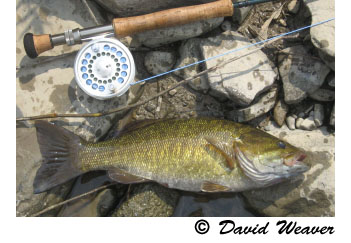 continue, no clear cause can yet be identified. The current studies suggest low dissolved oxygen and low, warm water may be at least partially the culprit in the failure of young bass to survive. Many frustrated anglers continue to debate different theories and possible causes among themselves (quite evident on the forums here on PaFlyFish). Another topic for debate revolves around what measures to implement to limit the decline and perhaps expedite the recovery of bass in these sections of river. Among the most common suggestions has long been implementation of catch and release regulations.
continue, no clear cause can yet be identified. The current studies suggest low dissolved oxygen and low, warm water may be at least partially the culprit in the failure of young bass to survive. Many frustrated anglers continue to debate different theories and possible causes among themselves (quite evident on the forums here on PaFlyFish). Another topic for debate revolves around what measures to implement to limit the decline and perhaps expedite the recovery of bass in these sections of river. Among the most common suggestions has long been implementation of catch and release regulations.
This week the PFBC led by their new Executive Director, John Arway, has announced this new catch and release policy will be put into effect at the beginning of 2011. At that point, all smallmouth bass in the Juniata River downstream of Port Royal, and in the Susquehanna downriver from Sunbury, will have to be released. Undoubtedly, this will be welcome news to many in the angling community. These sections of river have been managed under Big Bass regulations for a decade or so. Although these regulations have been embraced by many, in my opinion they may do greater damage by requiring anglers to release smaller bass and kill bigger fish. In particular, the 18” minimum size limit on smallmouths in effect during the colder months of the year is particularly worrisome to me. It’s not uncommon, especially during the pre-spawn, to see a boat at a ramp with a pair of...
October 6, 2010
For many of us in the Pennsylvania smallmouth bass fly fishing community, the decline of the bass fishery in the lower Susquehanna River, and to a lesser degree, the lower Juniata River, has been a source of sadness, concern, and hoped for recovery. While the cause of this decline has been intensely studied by the Pennsylvania Fish and Boat Commission (PFBC) and other agencies - and these studies

This week the PFBC led by their new Executive Director, John Arway, has announced this new catch and release policy will be put into effect at the beginning of 2011. At that point, all smallmouth bass in the Juniata River downstream of Port Royal, and in the Susquehanna downriver from Sunbury, will have to be released. Undoubtedly, this will be welcome news to many in the angling community. These sections of river have been managed under Big Bass regulations for a decade or so. Although these regulations have been embraced by many, in my opinion they may do greater damage by requiring anglers to release smaller bass and kill bigger fish. In particular, the 18” minimum size limit on smallmouths in effect during the colder months of the year is particularly worrisome to me. It’s not uncommon, especially during the pre-spawn, to see a boat at a ramp with a pair of...


